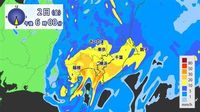On May 2, 2025, the Kanto region of Japan faced a deluge of heavy rain, leading to significant disruptions, particularly in Kanagawa Prefecture. Reports indicated that intense rainfall reached over 30mm per hour in various locations, resulting in widespread road flooding and affecting public transportation.
According to Weather News, the rain intensified in the evening as a low-pressure system approached the southern coast of Kanto. In Odawara City, a staggering 33.5mm of rain was recorded within just one hour, while Yokohama City saw 18.0mm and central Tokyo experienced 12.5mm during the same timeframe. This deluge raised alarms as the rain was expected to continue intermittently throughout the night, with forecasts predicting localized bursts exceeding 30mm per hour.
The situation was exacerbated by the fact that the heavy rain had already led to road flooding in many areas, with some railway services disrupted. The JR Tokaido Line, for example, suspended operations between Odawara and Atami due to the adverse weather conditions. Officials urged residents to exercise caution while commuting home, as the rain's peak was anticipated around 9 PM.
In addition to the heavy rainfall, there were warnings of potential lightning strikes and strong winds, particularly along coastal areas. The Japan Meteorological Agency advised that the rain could pose risks of inundation in low-lying regions and increased water levels in rivers.
As the rain swept across the region, it did not just disrupt daily life; it also impacted various events. At the Osaka-Kansai Expo, umbrellas blossomed inside the venue, creating a unique but chaotic atmosphere as attendees navigated the rain. Children were seen donning raincoats, while families struggled with soggy carry cases and baby strollers.
In Kanagawa, the Golden Week tourist spots, usually bustling with visitors, were hit hard by the rain. Tourists in Odawara were seen driving through flooded streets, while in Hakone, people braved strong winds with umbrellas. The heavy rain even affected the Yamaguchi Festival at Ise Grand Shrine, which was held to pray for the safety of timber harvesting for a new shrine slated for construction in 2033.
As the rain clouds moved from Kinki and Tokai towards Kanto, the scenery transformed dramatically. In Harajuku's Takeshita Street, typically crowded with tourists, the narrow paths became even more congested as people struggled to keep dry. The rain was so intense that even with umbrellas, many found their feet soaked.
At Tokyo's Ume City, rain began to fall heavily before noon, setting the stage for a day of disruption. The horizontal rain in Odaiba left tourists battling against the elements, with umbrellas flipping inside out as they attempted to navigate the storm.
By the afternoon, the rain had intensified to the point where the Kanagawa Prefecture issued a heavy rain warning. Officials reminded residents of the dangers posed by flooding, lightning, and strong winds as the storm progressed.
Despite the challenges posed by the weather, some events continued. At the Taiwan Festival at Tokyo Skytree, organizers provided covered seating for about 200 guests, allowing them to enjoy Taiwanese delicacies even amid the downpour. Katsutoshi Kai, an organizer of the festival, expressed optimism, stating, "We have prepared enough covered seating so that people can enjoy the event even in the rain."
The heavy rain across Kanto was not just a local phenomenon; it was part of a larger weather pattern affecting much of Japan. Nationwide, reports indicated that regions like Tokai were experiencing their heaviest rainfall of the year, with some areas in Mie Prefecture recording over 50mm of rain per hour.
As evening approached, the risk of warning-level heavy rain remained high. The Japan Meteorological Agency continued to advise caution, emphasizing the potential for flooding in low-lying areas, rising river levels, and the dangers of lightning and gusty winds.
In conclusion, the heavy rainfall on May 2, 2025, serves as a reminder of the unpredictable nature of weather patterns and their capacity to disrupt daily life and events. As Kanto residents braced for the evening commute, the resilience of the community shone through, with many finding ways to adapt to the challenges posed by the torrential downpour.





